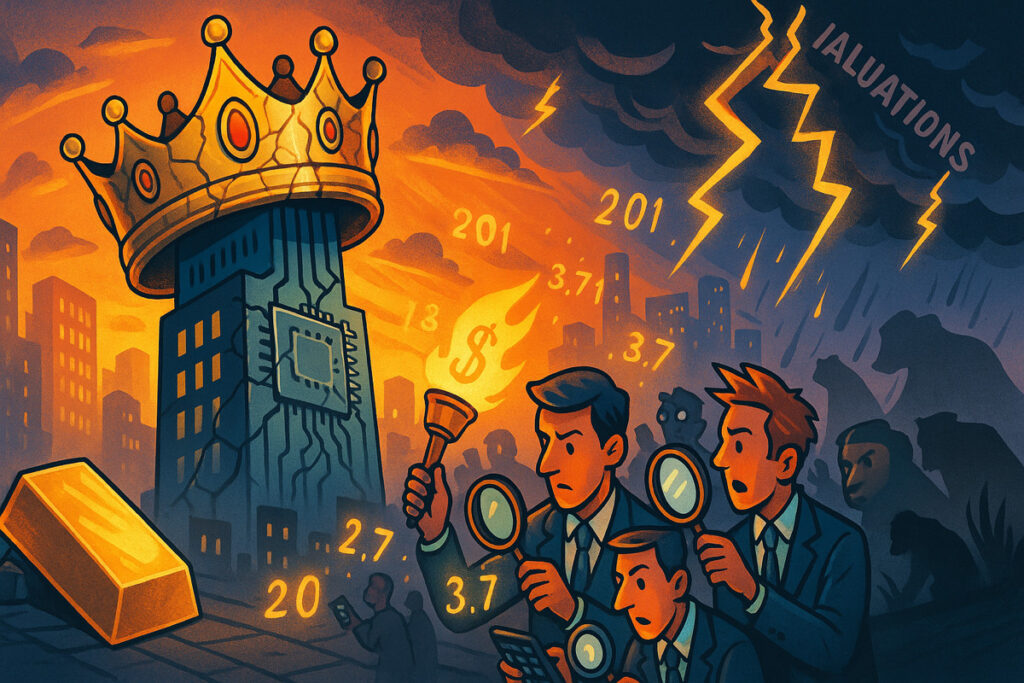Introduction
October 10, 2025 was a day of reflection — not of panic, but of recalibration. After weeks of record highs for the S&P 500 and Nasdaq, the mood shifted. Elevated valuations in the tech sector drew renewed warnings from major financial voices, while gold paused after its meteoric rally. With the U.S. government still partially shut down and economic data frozen, the markets now face a new question: how much higher can this run go before gravity reasserts itself?
This was not a day of crashes or collapses, but rather a moment when traders began to acknowledge the thin ice beneath the euphoria.
Body
The Numbers: Profit-Taking and Moderation
Major U.S. indices cooled off slightly. After a string of record-breaking sessions, the S&P 500 slipped about 0.3%, the Dow Jones lost 0.5%, and the Nasdaq remained virtually unchanged, with small downward swings. The Russell 2000, more sensitive to economic expectations, underperformed again.
This wasn’t a selloff — it was a breather. Investors appeared to be rebalancing and locking in gains rather than fleeing the market. The tone was cautious but rational: this was a market pausing to measure itself.
Gold: Taking a Breath, Not Surrendering
After its blistering rise, gold dropped about 2%, dipping just below the $4,000/oz mark. The move looked more technical than structural — a cooldown rather than a capitulation. Demand for safe-haven assets remains robust, especially in an environment of fiscal and political uncertainty.
That gold can rest near record levels instead of collapsing is telling: investors still see it as a crucial hedge. Its pause reflects consolidation, not exhaustion.
Valuation Warnings for Tech: Red Lights Flashing
The tech sector’s dominance is now facing scrutiny. Industry veterans and analysts alike are voicing concern that valuations, especially among AI platforms and semiconductor giants, have stretched too far ahead of earnings.
Prominent financial leaders have warned that the market is underestimating the risk of a major correction. Their remarks have revived discussions about whether this rally is broad and sustainable — or narrow and overextended.
Many now describe the current phase as a “rally of the few” — led by megacaps, while the rest of the market struggles to keep pace. The leadership remains concentrated, and that concentration makes fragility more visible.
Bonds, Yields, and the Risk of Inversion
Treasury yields moved only slightly. The 10-year yield rose modestly, while shorter maturities held firm, keeping pressure on the yield curve’s shape. The spread between the two remains narrow, hinting at lingering growth concerns.
Markets continue to price in an October rate cut, but with more hesitation. The narrative has shifted from “the Fed will ease” to “the Fed may be forced to.” Each new headline carries the potential to tilt expectations again.
Sector Breakdown: Who Leads, Who Lags
- Technology / AI / Semiconductors: showing signs of fatigue. Momentum is slowing even as valuations remain sky-high.
- Gold & Mining Equities: resilient, even with spot prices easing.
- Global Exporters / Industrials: mixed — currency weakness supports some, while input costs and supply delays drag others.
- Financials: cautious; yield curve dynamics offer selective opportunities but limited upside.
- Consumer / Retail: fragile, pressured by tepid demand and shrinking margins.
- Energy / Commodities: flat to slightly weaker as oil continues to reflect sluggish demand.
- Defensives (utilities, staples, healthcare): gaining quiet appeal as risk appetite softens.
In short, it’s not a rotation — yet. But subtle shifts are forming beneath the surface.
Currencies and Global Perspective
The U.S. dollar strengthened slightly, a typical reflex as risk appetite eased. Emerging-market currencies were mixed, with commodity-linked pairs under pressure.
The yen stayed weak, supporting Japan’s exporters, while the euro remained fragile amid ongoing European political tremors.
Globally, the message is clear: momentum is fragmenting. The rally that once felt synchronized is now selective, more dependent on narrative than fundamentals.
Market Psychology: Respecting the Waves
Investors are cautious, not fearful. Profit-taking is rational, not reactionary. The “barbell” strategy — combining growth exposure with safe hedges — remains dominant.
Low volatility is deceptive: under the surface, traders are hedging aggressively. The skew in options pricing reflects an underlying awareness that calm can break at any moment. With no official data to anchor expectations, perception and positioning are the new fundamentals.
This market isn’t exhausted — it’s aware of its own vulnerability.
Conclusion
October 10, 2025 wasn’t a dramatic day, but it was an important one. The rally remains intact, yet the tone has changed. Tech’s brilliance now carries warning lights, and gold’s pause reflects maturity rather than weakness.
The market continues to climb — but now with eyes wide open.
Key Questions Ahead
- Will concerns about tech valuations trigger a real correction, or simply fade into the background?
- Can gold resume its surge, or has it entered a consolidation phase?
- Do earnings have the strength to justify current price multiples?
- Will the absence of macro data continue to favor narrative-driven trading, or undermine confidence?
- If a surprise emerges — policy, inflation, or geopolitics — which way will the balance tip?
The rally isn’t over, but it’s shifting. October 10 will be remembered as a day when euphoria took a breath, and prudence returned to the table — a calm between the signals, as markets began to measure their own reflection.
